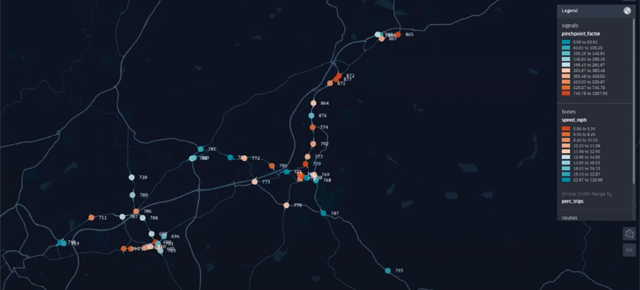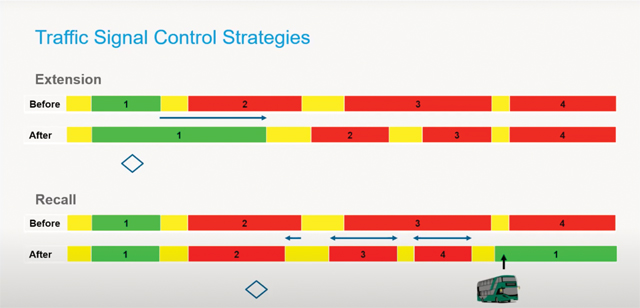Lancashire County Council has adopted digital bus priority as a means of improving journey times without the need for expensive infrastructure

By Andrew Garnett
Could there be an easier, cheaper and more effective way of creating new bus priority measures without resorting to expensive infrastructure interventions?
Consultancy Atkins thinks so and those tuning in to BRTuk’s third Lunchtime Masterclass last week discovered how intelligent bus priority could open the door to widespread bus journey time improvements.
But what is it? Tony Brown of Atkins said it’s primarily the use of traffic control systems and signals to enable bus priority rather than the use of more conventional “concrete and tarmac” to improve bus services. “Bus priority has been an issue for as long as I’ve worked in the sector,” he said. “It’s worth pointing out that intelligent bus priority is more about improving and smoothing journey times.”
He pointed to research by Transport Focus which regularly finds passengers are seeking more consistent journey times and buses arriving at stops on time. “If they get that they’re quite happy to travel,” Brown added. He also said it was important to acknowledge that digital priority interventions would support that goal – it wasn’t a case of shaving several minutes from journey times; it’s about creating consistency.
When I first started the focus was all about expanding capacity by building infrastructure
“When I first started the focus was all about expanding capacity by building infrastructure,” he said. “That is important and to both passengers and car drivers it’s visible and it clearly reduces bus journey times if you’re segregating the bus from the rest of the traffic. It’s sending out all the right sounds and doing all the right things.”
However, Brown said these sorts of interventions were expensive, very difficult and time-consuming. That makes many physical schemes very difficult and there is always political and other user opposition to the reallocation of road space. There are also problems stemming from the construction phases of such schemes where there can be significant disruption. “When they are in, for it to be efficient, you need enforcement,” he added. “So you’re adding an additional layer of cost and complexity. When something is enforced you’ve also got the public – I wouldn’t say backlash – but you’ve got public criticism.”
Is there another way?
Brown said many local authorities began to move to new-generation digital control of traffic lights in the 1990s and this technology offered an opportunity by having the capability to allow buses priority at traffic lights. He described the benefits these schemes offered as being “more in the background” as they were less contentious than introducing bus lanes or other physical, and not to mention highly visible, bus priority interventions.
But there were problems with these early systems as they could be expensive when they reached any sort of scale and, as they required tags to be installed on buses to trigger sensors attached to the traffic lights. They also required the right buses to be used on the right route, which reduced flexibility for operators.
Luckily technology has advanced and today the problematic sensors and tags of early schemes have been replaced by digital messaging technology. It means on-bus real-time information systems and the latest GPS-enabled electronic ticket machines can “talk” with the digital Urban Traffic Control (UTC) system of any given local authority. To throw in some more jargon, this process uses the open standards of Urban Traffic Management Control (UTMC) that allow different applications used within modern traffic management systems to communicate and share information with each other.
Brown says the move to UTMC means there are opportunities to introduce strategy-based interventions as well as ongoing evaluation of how they are working out on the ground. “You can check how your system is performing,” he added. “You can get down into the detail, look at the journey times and understand why the delays are happening.”
Lancashire goes digital
These rapid developments in the sphere of digital bus priority have been adopted by Lancashire County Council where it is an emerging policy driver to improve bus journey times and reliability across the county.
“They are putting a lot of emphasis on bus priority,” explained Brown. “They found, partly when putting together their BSIP, that bus lanes are often cost-prohibitive. They wanted a more cost-effective solution.”
Meanwhile, Lancashire’s decision to adopt UTMC was also a catalyst to press ahead with the project. “What was key for Lancashire was they wanted a data-driven, evidence-based assessment to support these proposals,” Brown added. “That’s where we brought in Alchera to help us with that.”
Getting the data right
Aaron Croucher from Alchera Technologies explained how Atkins had brought in his company to find the road junctions in Lancashire where the greatest improvements would be made. He said this approach aimed to create small improvements in the passage of buses through traffic lights that would add up to be improvements overall.
Alchera used its data expertise to scrutinise road junctions across East Lancashire. Croucher explained that around the town of Nelson there are 60 junctions. But which would be the best to target? UTMC data allowed Alchera’s pinch point analysis software to determine some junctions were already working effectively but others needed improvements as buses were frequently delayed.
We use the analytics to create pinch point results to answer three questions: firstly, how many buses are affected by each junction; secondly, how much variability does each junction cause for those buses; and thirdly how much are those buses slowed down as they pass through that junction?
“We use the analytics to create pinch point results to answer three questions: firstly, how many buses are affected by each junction; secondly, how much variability does each junction cause for those buses; and thirdly how much are those buses slowed down as they pass through that junction?”
Lancashire’s need for an evidence-based approach saw Alchera use its analysis to produce results that would determine qualitative benefits. Rather than relying on on-street observations, the pinch point analysis software crunched the numbers quickly, producing a downloadable spreadsheet with a complete set of results for each junction. It even ranked the junctions, highlighting which would offer the greatest financial return on investment per year if improved.
“Lancashire is now using this to justify putting traffic light priority in at junctions,” added Croucher. “Importantly our product is staying behind to monitor these interventions and monitor these junctions.”
That process aims to constantly scrutinise the junctions in an effort to determine what if anything has made the junction become a pinch point again. “Maybe something has changed in the local area,” he added. “It alerts the teams and consultants to go and check that and to fix it. Maybe a tweak to the traffic light priority settings, so that it can be fixed and returned to a nicely flowing junction with consistent bus times.”
The benefits of digital
But how do the bus’s digital systems interact with the traffic lights? Robert Mansell of Atkins aimed to give viewers more on that. “There are three things we need to look at – detecting the buses, communicating with the traffic control system and actually controlling the traffic signals,”
he explained.
While traditional systems used loops buried in the ground at junctions and traffic lights, modern systems rely on a ‘virtual’ loops that use GPS data from on-bus systems. Mansell outlined there are some significant benefits in that the overwhelming majority of buses in the UK are now fitted with RTPI systems that pass data about the bus’s location to the RTPI server every 30 seconds.
This data is then handed on to the UTC server of the local authority which determines the actions that should be taken in order to smooth the passage of each bus through junctions. This may see the green phase extended (called ‘extension’ in the trade) or red phases in other directions shortened in order to cycle swiftly through to a green phase (called ‘recall’). Mansell explained that while ‘extension’ was the ideal, ‘recall’ aimed to get the buses moving as soon as possible.
It’s clear the technology shows promise as a means of beating congestion cost-effectively. Brown said digital bus priority has moved from “a whizzy, techy approach that was all a bit dark arts” to now focussing on technology that does have a genuine business case. “We are getting to the point where we can build quite a compelling business case,” he added.

LUNCHTIME MASTERCLASSES, sponsored by Atkins
May 19: Peter Shelley of Portsmouth City Council on Bus Service Improvement Plans. ‘Be careful what you wish for!’ – VIEW HERE.
May 26: Angela Hosford of Transport for West Midlands on Sprint – VIEW HERE.
June 9: Tony Brown of Atkins on ‘Intelligent Bus Priority’ – VIEW HERE.
June 16: Liz Helen Rosenkilda Christensen on ‘Busveien’, 50kms of busway in Stavanger region of Norway – VIEW HERE.
June 23: Thomas Ableman, director of innovation at Transport for London, asks ‘Why Innovation?’
June 30: Shane Hymers of Kent County Council on Fastrack.
July 7: Robert Montgomery of Busesreinvented.com discusses ‘UK Bus: Delivering the promised land – sharing the spend and the spoils.’
ABOUT BRTuk
BRTuk has members from across the industry, including operators, promoters, manufacturers and consultants. It serves as an information hub and engages with all levels of government. Visit: www.brtuk.com
This article appears in the latest issue of Passenger Transport.
DON’T MISS OUT – GET YOUR COPY! – click here to subscribe!








